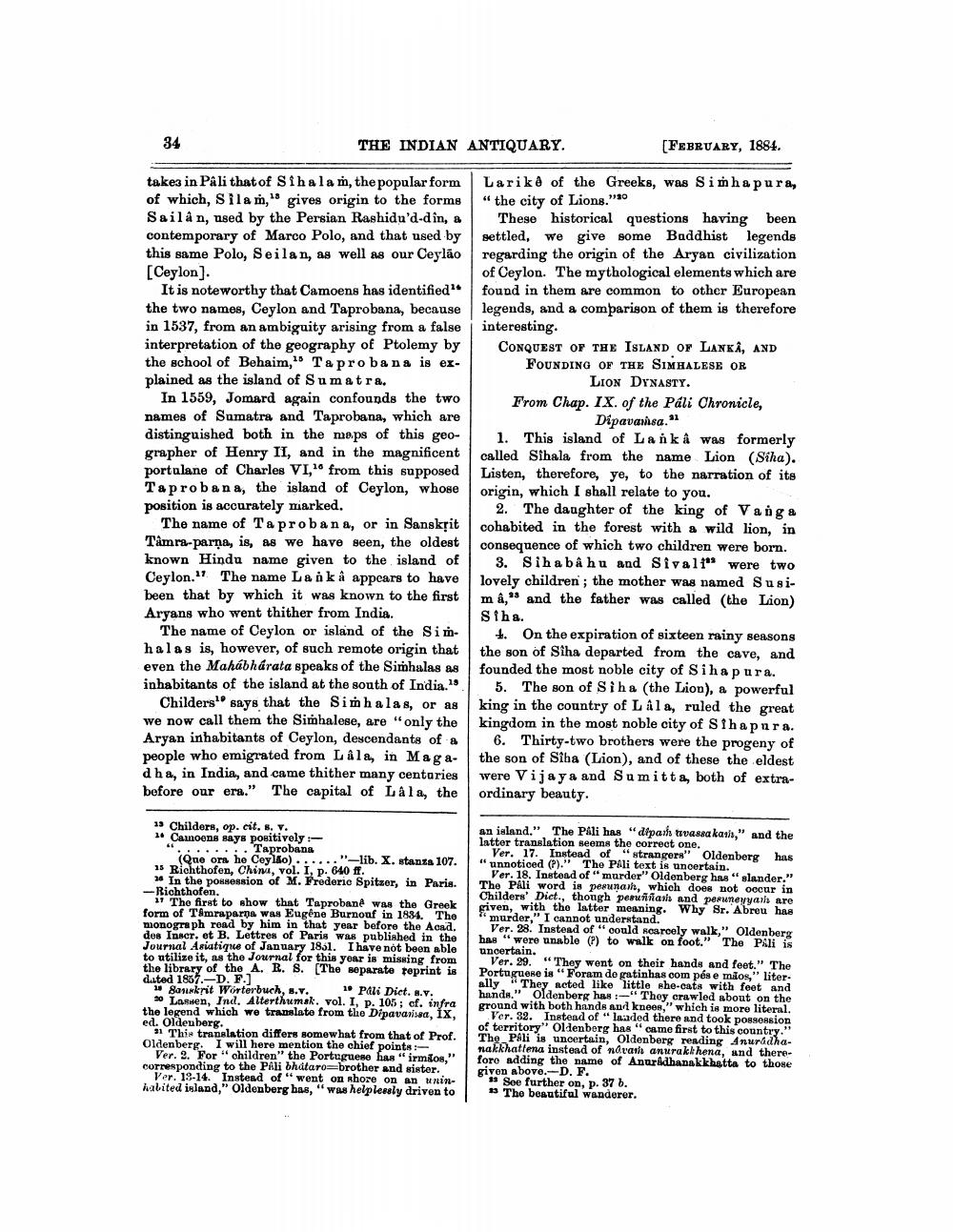________________
34
THE INDIAN ANTIQUARY.
[FEBRUARY, 1884.
takes in Pali that of Sihalań, the popular form Larike of the Greeks, was Simhapura, of which, Silam," gives origin to the forms "the city of Lions."0 Sailân, used by the Persian Rashidu'd-din, # These historical questions having been contemporary of Marco Polo, and that used by settled, we give some Buddhist legends this same Polo, Seilan, as well as our Ceylão regarding the origin of the Aryan civilization [Ceylon)
of Ceylon. The mythological elements which are It is noteworthy that Camoens has identified found in them are common to other European the two names, Ceylon and Taprobana, because legends, and a comparison of them is therefore in 1537, from an ambiguity arising from a false interesting. interpretation of the geography of Ptolemy by CONQUEST OF THE ISLAND OF LANKA, AND the school of Behaim, Tapro bana is ex
FOUNDING OF THE SIMHALESE OR plained as the island of Sumatra.
LION DYNASTY. In 1559, Jomard again confounds the two
From Chap. IX. of the Pali Chronicle, names of Sumatra and Taprobana, which are
Dipavarisa." distinguished both in the maps of this geo- 1. This island of La nk & was formerly grapher of Henry II, and in the magnificent called Sthala from the name Lion (Siha). portulane of Charles VI, from this supposed Listen, therefore, ye, to the narration of its Taprobana, the island of Ceylon, whose origin, which I shall relate to you. position is accurately marked.
2. The daughter of the king of Vanga The name of Ta probana, or in Sanskțit cohabited in the forest with a wild lion, in Tâmra-parna, is, as we have seen, the oldest consequence of which two children were born. known Hindu name given to the island of 3. Sihaba hu and Sivalf" were two Ceylon." The name La i k à appears to have lovely children; the mother was named Susibeen that by which it was known to the first ma," and the father was called (the Lion) Aryans who went thither from India.
Siha. The name of Ceylon or island of the Sim . On the expiration of sixteen rainy seasons halas is, however, of such remote origin that the son of Siha departed from the cave, and even the Mahabharata speaks of the Simhalas as founded the most noble city of Sihapura. inhabitants of the island at the south of India. 5. The son of Siha (the Lion), a powerful
Childers' says that the Simh alas, or as king in the country of L ala, ruled the great we now call them the Simhalese, are "only the | kingdom in the most noble city of Sihapura. Aryan inhabitants of Ceylon, descendants of a 6. Thirty-two brothers were the progeny of people who emigrated from Lala, in Maga- the son of Siha (Lion), and of these the eldest dha, in India, and came thither many centuries were Vijaya and Sumitta, both of extrabefore our era." The capital of Lala, the ordinary beauty.
13 Childers, op. cit. . v. * Camoens says positively :(Qae ora he Ceylko)... ..."-lib. X. stanza 107.
.:: Taprobana 15 Richthofen, China, vol. I, p. 640 ff.
In the possession of M. Frederic Spitzor, in Paris. -Richthofen.
11 The first to show that Taproband was the Greek form of Tamraparna was Eugêne Burnouf in 1884. The monograph road by him in that year before the Acad. des Inacr. et B. Lettres of Paris was published in the Journal Asiatique of January 1861. I have not been able to utilize it, as the Journal for this year is missing from the library of the A. R. S. The separate teprint is dated 1857.-D.F.)
19 Sanskrit Wörterbuch, B.v. 1o Pali Dict. .y.
90 Lassen, Ind. Alterthumsk. vol. I, p. 105; cf. infra the legend which wo translate from the Dipavarissa. IX. ed. Oldeuberg.
31 This translation differs somewhat from that of Prof. Oldenbers. I will here mention the chief points
Ver. 2. For children" the Portuguese has "irmlos." corresponding to the PAli bhataro-brother and sister.
Ver. 13-14. Instead of " went on shore on an uninhabited island," Oldenberg has," was helplessly driven to
an island." The Pali has "dipari tuvassa kasi," and the latter translation seems the correct one.
Ver. 17. Instead of "strangera" Oldenberg has "unnoticed (?)." The PAli text is uncertain.
Ver. 18. Instead of " murder" Oldenberg has" slander." The PAli word is perunait, which does not occur in Childers' Dict., though perusasis and peruneyyarls are given, with the latter meaning. Why Sr. Abreu has murder," I cannot understand.
Ver. 28. Instead of " could scarcely walk," Oldenberg has " were unable (?) to walk on foot." The PAli is uncertain.
Ver. 29. They went on their hands and feet." The Portuguese is "Foram do gatinhas com pés e mios," literally *They acted like little she-cats with feet and hands." Oldenberg has :-"They crawled about on the ground with both hands and knees," which is more literal.
Ver. 32. Instead of "landed there and took possession of territory Oldenberg has" came first to this country." The Pali is uncertain, Oldenberg reading Anuradhanakkhattena instond of nduaris anurakkhena, and thereforo adding the name of Anuradhanakkhatta to those given above.-D. F. 19 See further on, p. 37 b. 13 The beautiful wanderer.




